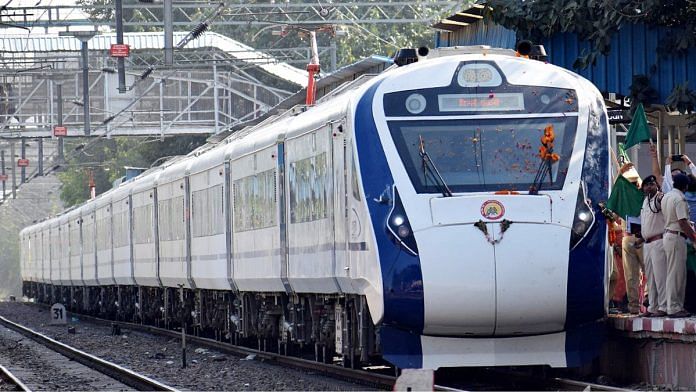New Delhi: The indigenously manufactured Vande Bharat Express is transforming India’s 170-year-old railway system for the 21st century. And to do so, the self propelled semi-high speed train heavily relies on technology.
In a recent meeting with the media, Union Minister for Railways Ashwini Vaishnaw had referred to the Vande Bharat Express as a ‘computer on wheels’.
The ‘smart train’ is equipped with integrated circuits (ICs) – or chips – to control almost all of its operations, from propulsion to braking to automatic doors.
“Vande Bharat is practically a computer on wheels,” said Vaishnaw. “Its vehicle control system, power electronics, powertrain… from the transformer at the top to the motor at the bottom, everything is software-defined and controlled. Thousands of chips are used in a Vande Bharat train.”
ThePrint found out how many chips are used in a typical Vande Bharat train, and what they do.
According to a source in the Railway Ministry, the Vande Bharat Express is equipped with about 15,000 ICs. The train has a 16-coach configuration with four basic units – each unit consisting of two motorised cars and two trailer cars they pull.
Also read: Govt uses AI to weed out mobile connections based on fake IDs, 37 lakh connections culled so far
Advanced train control management
In a regular train, the locomotive – which pulls the other trailing coaches – houses all major electronic components such as traction converters, auxiliary converter and vehicle control unit, and has about 2,000 ICs, a senior engineer at the Integral Coach Factory, Chennai, told ThePrint over the phone.
However, the remaining coaches do not have much electrical component, besides LEDs and air conditioners, he said.
Vande Bharat, on the other hand, has eight motor coaches, meaning 50 per cent of the coaches in the train are self-propelled or can move on their own, in contrast to conventional locomotive trains where only one coach moves on its own.
“So, automatically, the number of chips gets multiplied,” the engineer cited above said. “The motor coach in Vande Bharat has some common functionalities as a locomotive and will have a traction converter, auxiliary converter and a vehicle control unit.”
“But, in addition, Vande Bharat has an intelligent braking system, door system and the TCMS (train control management system),” he added. “The entire functionality of the train is driven by TCMS. It is like a computer in each coach, and all connected by a network.”
Besides, all coaches have AC control, automatic doors, sensors, GPS-based passenger information system, CCTV, and infotainment system – all of which are electronic and require the use of electronic chips.
The TCMS is the heart of modern rail transportation and is responsible for controlling and monitoring numerous systems such as traction (propulsion), braking, heating, ventilation, air conditioning, and passenger information systems.
Besides, it also helps in data analysis to enable implementation of condition-based and predictive maintenance. The TCMS also uses sensors and data analytics to monitor the performance of equipment, so as to predict when maintenance is required. This helps in identifying potential failures before they occur.
Data analytics and machine learning algorithms used under the TCMS also help optimise energy usage. For example, the system can help reduce energy consumption by optimising usage based on the topography of the route.
Additionally, the TCMS also enables real-time monitoring and allows different subsystems to communicate with each other. For example, the traction and braking systems can communicate with each other to ensure smooth acceleration and deceleration.
(Edited by Smriti Sinha)
Also read: Cabinet approves Rs 17,000 crore reworked PLI scheme for IT hardware



